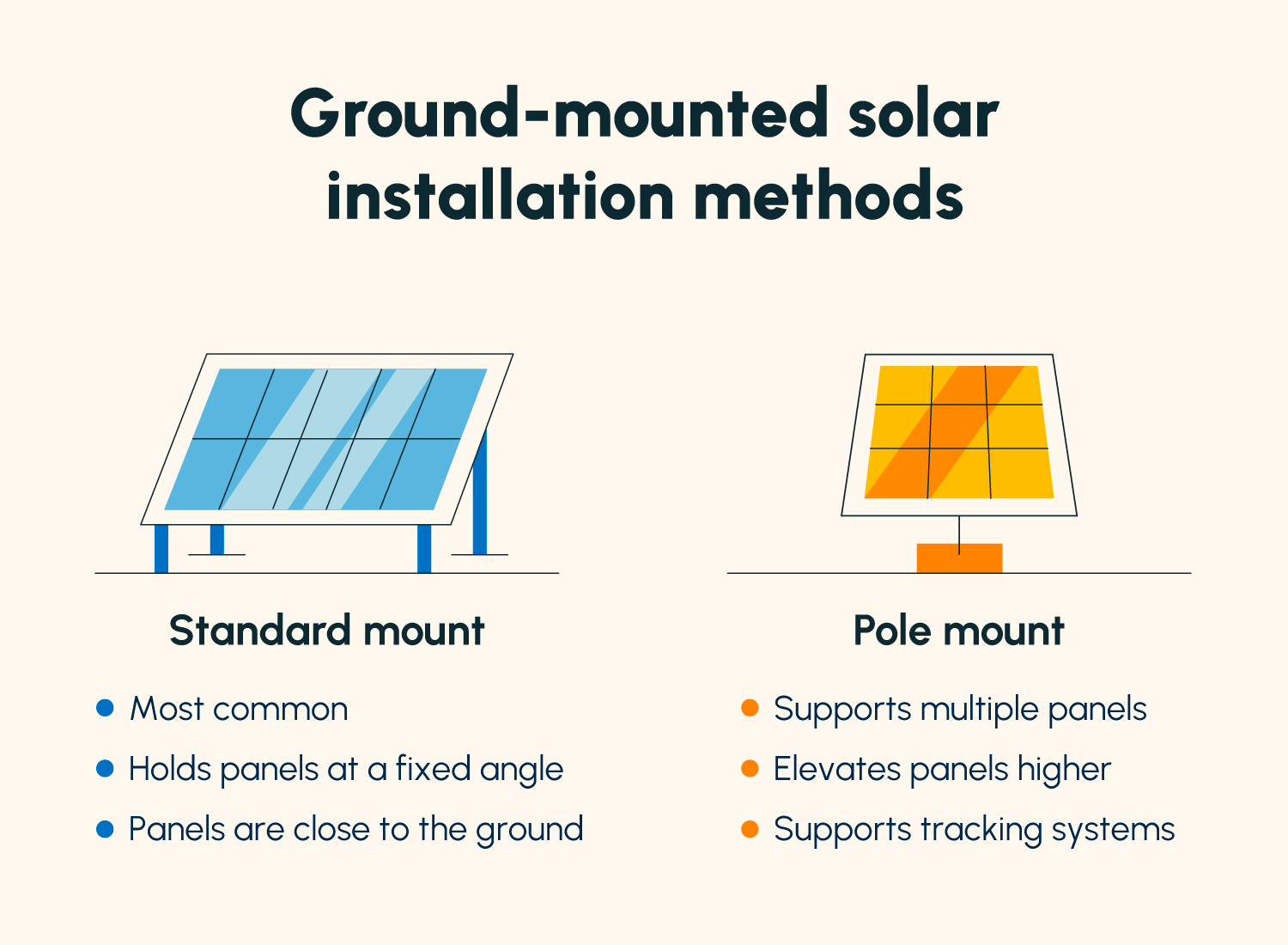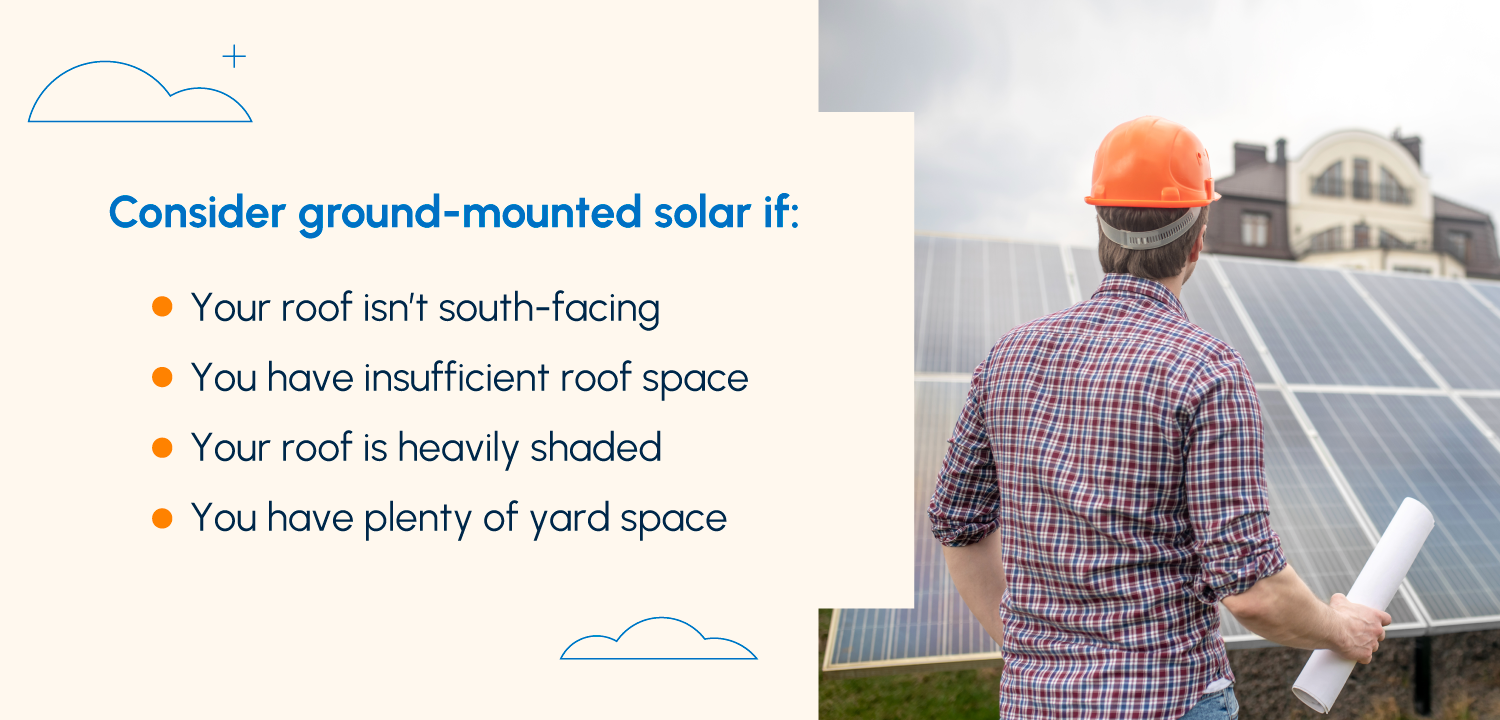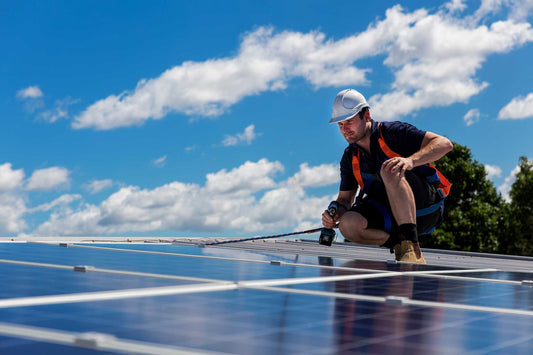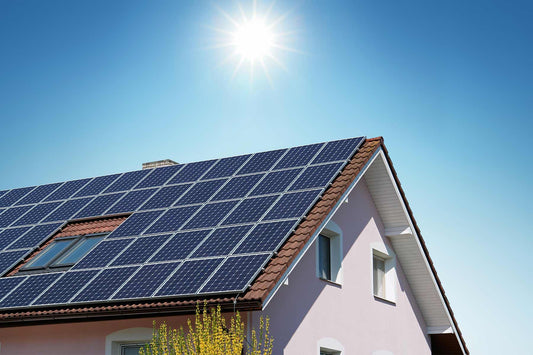By now, you’ve probably driven through enough suburban neighborhoods to notice that solar panels are usually installed on rooftops. While this is the most common way to install residential solar, it’s certainly not the only way.
For some living situations and home orientations, rooftop solar isn’t ideal. Thankfully, this doesn’t mean you have to rule out solar altogether. There are options that don’t involve your home’s roof, such as ground-mounted solar panels.
In this guide, we’ll unpack how ground-mounted solar panels work, including installation methods and important considerations when determining whether they’re right for you.
What Are Ground-Mounted Solar Panels?

As the name implies, ground-mounted solar panels (also known as free-standing solar panels or backyard solar panels) are standard solar panels that are installed on the ground using a solar panel ground mount or pole.
Ground-mounted panels often get better sun exposure than rooftop panels because they allow for greater flexibility with regard to positioning. While rooftop panels are limited by the roof’s direction and slant, ground-mounted panels can be adjusted relatively freely.
For this reason, homeowners with a suboptimally positioned roof and sufficient land may consider ground-mounted panels over rooftop panels.
Ground-Mounted Solar Installation
Before you install ground-mounted panels, it’s important to do some planning. Below, we describe your installation options and help you determine which is right for you.
1. Determine How Many Ground-Mounted Panels You’ll Need
Just as you would with a rooftop solar system, you need to size your system before moving forward with purchasing and installing your panels. Let’s walk through how many panels the average home would need.
Assuming you invest in 325 W panels in an area that gets 4.5 peak sun hours daily, each panel will produce about 1.46 kWh of electricity per day.
Based on data from the U.S. Energy Information Administration (EIA), in 2020 the average residential utility customer’s electricity usage amounted to about 900 kWh per month, or 30 kWh per day.
Divide average daily electricity use (30 kWh) by each panel’s daily production (1.46 kWh), and you get 20.5. Round this number up to determine that the average household would need about 21 panels to power the entire house.
For an estimate better tailored to your own needs, check out our guide to solar system sizing.
2. Choose an Installation Format

There are two main installation styles for ground-mounted panels: standard ground mounts and pole mounts. We compare each option below.
Standard Ground Mount
Standard or traditional ground mounts use metal framing anchored into the ground to hold solar panels in a specific position.
These mounts usually keep panels held at a fixed angle year-round, though adjustable options for following the sun’s seasonal movements are becoming increasingly common. While they’re usually anchored using concrete piers, other options such as driven piers can also be used.
As the easiest and least expensive ground-mounting method, standard ground mounts are the most common way to install ground-mounted panels.
Pole Mount
Whereas standard ground mount systems are usually supported by multiple anchors, pole mount systems are supported by a single pole anchored into the ground.
Pole mounts can support multiple panels and elevate them higher than standard ground mounts. This keeps panels safe from ground obstructions such as foliage and animals.
Pole-mount systems also usually include a single- or dual-axis tracking system, which automatically adjusts your panels’ angle to follow the sun and maximize solar energy collection. Single-axis systems tilt your panels to follow the sun throughout the day whereas dual-axis systems also adjust based on seasonal changes in the sun’s position.
| Standard mount | Pole mount | |
|---|---|---|
| Pros |
|
|
| Cons |
|
|
3. Choose an Installation Method: Professional or DIY
While not the most common option for ground-mounted solar systems, DIY installation using a ground-mounted solar kit is possible (plus, it’s a great way to save money on system installation).
That said, ground-mounted installation is usually more challenging and requires more expert knowledge than rooftop solar installation.
Not only does it require careful design and the collection of necessary approvals beforehand, but anchoring solar arrays usually warrants the use of excavators and concrete. Wiring from the system to your home is also usually routed underground, which requires trenching — a heavier lift for a DIY project.
Before moving forward with a DIY installation, be sure to do your research.
Pros and Cons of a Ground-Mounted Solar System
| Advantages | Disadvantages |
|---|---|
| Can be optimally positioned for maximum energy production | Occupies real estate on your property |
| Keeps panels off the roof to avoid visual or practical issues | More costly than rooftop solar |
| Easy access for cleaning and maintenance | More challenging and costly to install |
| Vulnerable to vandalism and wildlife |
Ground-mounted solar panels aren’t for everyone, but they offer some unique benefits that should be considered before ruling them out. Below, we explore the pros and cons of this solar panel installation method.
Ground-Mounted Solar Pros
The advantages of ground-mounted solar systems include:
- Ideal sun exposure: Rooftop solar systems must be placed according to the fixed placement of the roof itself. Ground-mounted systems, on the other hand, can be carefully positioned to maximize sun exposure.
- Improved efficiency: While rooftop panels are often flush against the roof itself, ground-mounted panels usually have plenty of open space underneath them. This improves air circulation, which helps keep your panels cool and improves their efficiency.
- Easier maintenance: When rooftop panels malfunction, a technician may need to scale your roof to fix them. Ground-mounted panels are far easier to access and fix if anything goes wrong.
Ground-Mounted Solar Cons
The disadvantages of ground-mounted solar systems include:
- Greater real estate demand: Roofs tend to be unused space — there isn’t much you’d put on top of your roof aside from solar panels. Land, on the other hand, is valuable space that can be used for anything. Ground-mounted solar panels take up a significant amount of space that could otherwise be used for something else.
- More vulnerability: The accessibility of ground-mounted panels has a downside — they are more likely to be tampered with by vandals or curious wildlife. Keeping them safe may require regular surveillance.
- Higher price point: The additional materials and labor required for ground-mounted solar panels makes them more expensive than rooftop panels. Ground-mounted installation is typically about 20% more expensive than rooftop installation.
- Challenging installation: Installing ground-mounted solar panels requires heavy excavation, the use of concrete, and trenching for underground wiring. This process is much more labor-intensive than the process of installing rooftop solar, contributing to its higher price point.
Additional Non-Roof Solar Panel Options

If you’d prefer to avoid rooftop solar but ground-mounted panels don’t feel right for you, there are other creative ways to mount solar panels that keep them off of your roof and off the ground.
Shed or Garage
If you have a shed or detached garage in your yard, this presents an excellent opportunity to install out-of-sight solar panels.
Of course, this option is best for smaller solar systems since most sheds don’t have ample roof space. If your existing shed doesn’t quite have solar potential, you may need to upgrade it in order to house your solar system here.
Awning or Overhang
If you don’t mind the look of solar panels and are OK with integrating them with the rest of your house, consider adding them to an awning or overhang.
Not only is this a space-efficient way to install your solar panels while keeping the rest of your roof clear, but it also helps keep your panels cool in the summer, improving their efficiency.
Gazebo
Gazebos provide a nice outdoor space to relax in the shade on warm days, but they also present a great opportunity for installing backyard solar panels. Connect your gazebo solar system directly to your outdoor appliances or pool to power them using less wiring.
South-Facing Wall
Solar panels require very specific positioning in order to produce energy at their maximum potential. Specifically, they should be facing south or slightly southwest in order to perform most efficiently. This holds especially true for wall installations.
If you happen to have a wall facing one of these directions, you can install some panels on the side of your house using a wall mount.
RV or Camper Van
If you’re an outdoor enthusiast, don’t forget to add solar panels to your RV or camper van before setting off on your next adventure. Mount them to the roof of your RV to never be without electricity, even as you adventure far from the grid.
Boat
If you live a more nautical lifestyle and want to power your devices as you embark on the water, consider adding solar panels to your boat. Easily connect your panels to the boat’s railing or body with a marine mount, putting them in prime view of the sun’s rays.
Is an Alternative Solar Panel Installation Method Right for Me?

Rooftop solar systems are the most popular residential solar format for a reason — they’re centrally located on top of the house where electricity is used most and occupy space that isn’t otherwise being used. That said, rooftop solar doesn’t work for everyone.
If any of the following situations are true for you, you may want to consider an alternative solar panel installation method, such as ground-mounted panels:
- Your roof isn’t angled ideally and doesn’t face south or southwest
- Much of your roof space is occupied by large skylights or chimneys
- Your roof is shaded by large trees or other obstructions
- You have plenty of open, unused yard space
- You have a gazebo, a detached shed or garage, or south-facing awnings
Remember, even if you have some optimal space on your roof, it may not be enough to match your energy consumption. As long as you have sufficient land to put them on, ground-mounted solar systems can be as big as you need them to be.
Carefully assess your real estate availability and potentially consult with an expert before determining your ideal solar installation method.
FAQ: Solar Panels Not on Roof
Many prospective solar customers may see solar panels as limited to rooftops, and other installation methods may feel foreign. We answer some of the most common questions about non-roof solar installation methods below.
Do Solar Panels Have to Be Installed on the Roof?
No, solar panels do not have to be installed on the roof.
There are several options for solar panel installation off of the roof, including ground-mounted panels (the most popular alternative) and panels placed on structures like sheds or gazebos.
How Much Do Ground-Mounted Solar Panels Cost?
As we’ve established, mounting solar panels in the ground is more expensive than mounting them on a roof — typically, by around 20%.
After incentives, Solartap’s roof mount pricing costs between $1.15 and $1.60 per watt. Ground-mounting increases that cost by anywhere from $500 to $3,000 total depending on your selected ground mount solution and the number of panels you’re installing.
How Far Can Solar Panels Be From a House?
One downside to ground-mounted solar panels is that they have to be installed further from the house than roof-mounted panels.
While hopefully they can be placed significantly closer, solar panels can be placed a maximum of 500 feet away from the house. The further away the panels are, the more expensive installation and wiring becomes.
Can Solar Panels Be Installed on a Wall?
Solar panels can be installed on south- or slightly southwest-facing walls. They shouldn’t be installed on walls facing any other direction, as this would significantly decrease their productivity.
If your home isn’t equipped for rooftop solar, ground-mounted solar is a great alternative that offers a number of unique benefits.
If you find that an alternative solar installation method is right for you, explore our solar accessories or get a quote using our solar calculator today.




